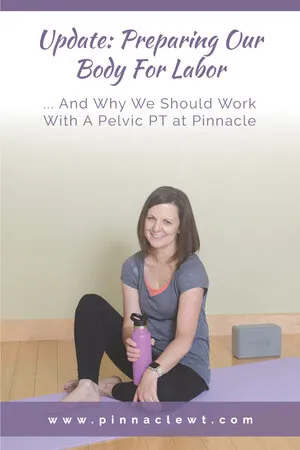{Read to the end for our free guide, info on our Birth Ready class, and more!}
When it came to expecting my babies (we have 3), I would wholeheartedly say that I LOVED buying little baby items and decorating their nursery. It was easy to get sucked into Pinterest for HOURS looking at all the cute baby things, baby decor, what to pack for the hospital, and on and on. You could easily say that this is what preparing for the arrival of a baby should look like.
But what about actually preparing our BODY for the process of BIRTH??
If you looked for a book on this online, you won’t see much at all. What I DID find plenty of, is how to NOT GAIN TOO MUCH WEIGHT, or HOW TO LOSE THE WEIGHT. Figures right?
Well, after my own 3 births and specializing in pelvic health for the last 10 of my 14 years as a PT, I can confidently say that MANY expecting women will have issues that would make childbirth MORE DIFFICULT for them. (but don’t worry, these issues can be resolved!)
SAY WHAT??
As much as everyone says that childbirth is natural, more than a THIRD of deliveries are by cesarean section in the U.S. Many women have prolonged or unsuccessful pushing. A large percent also have perineal tearing.
As I see many expecting women for various reasons, I have been able to assess their bodies for signs of potential difficulty with their labor. This can include:
-
Reduced range of motion or flexibility in their hips or pelvis
-
Difficulty connecting to quality breathing and coordinating their core muscles with their breath
-
And very often I see women with over-tense (and often painful or tender) pelvic floor muscles who are unable to relax them.
When it comes to the second stage of labor, which is the phase where the baby descends into and out of the pelvis (the part where we push), our bodies need to be able to be pliable. Both our hip and pelvis joints and our pelvic floor muscles. The relaxin hormone can only do so much if we have really tight hip muscles and a pelvic floor muscle group that is in spasm.
And when we are told to “Push”, MANY WOMEN WILL ONLY KNOW HOW TO KEGEL. They may have NEVER before in their life known how to relax and bulge their pelvic floor muscles outward. After all, the ONLY thing we’ve ever been told to do throughout our pregnancy was to “do our kegels”. And many women are not even sure what that means.
The difficulty with this reality, is that a nice and detailed verbal or written description of what our pelvic floor muscles SHOULD be able to do will NOT TRANSLATE to our bodies actually being successful at DOING THIS. MOST women that I see as patients come to me first with very little understanding of how to coordinate their pelvic floor muscles. This is no surprise when no one has ever talked through what the muscles are and how they work.
And as an experienced pelvic PT, would you think that I would have an idea of if my patient could coordinate their pelvic floor and core without actually assessing these muscles? DEFINITELY NOT. I can gather MANY clues by taking a detailed history and assessing their outside muscles and joints from their head to their toes, their coordination with breathing, and more, but I still won’t be able to predict what their pelvic floor muscles will be like.
This is where a full prenatal assessment including assessing the pelvic floor muscles would be INCREDIBLY HELPFUL to a woman who is preparing for childbirth. The benefits are MANY.
-
Identified pelvic floor issues can be resolved BEFORE due date
-
Patient feels CONFIDENT that she can PUSH effectively
-
Patient will be AHEAD OF THE GAME with her POSTPARTUM HEALING as she will already have learned how to connect to her core and pelvic floor. (learning this in those newborn months is NOT IDEAL)
-
Patient will KNOW how to USE HER BREATH EFFECTIVELY DURING LABOR
Why should we be assessed during the 2nd trimester?
It is considered the most safe to wait after 12 weeks for a pelvic assessment. But we don’t want to push this assessment to the third trimester if we can help it. The reason is that IF we DID have issues like uncoordinated core muscles or muscles that were in spasm, we would NEED the TIME to work these issues out with a pelvic PT BEFORE our due date.
Not only will we be prepared for labor, but we will also discuss the early postpartum weeks and how to best protect her body to ensure the best possible recovery. So many women who have suffered pelvic floor injuries during the early postpartum weeks voice their frustration over NOT being warned that pelvic floor injuries can happen and what they could have done differently.
At Pinnacle, we are VERY passionate about supporting women on their pregnancy and postpartum journey. We now offer a 4 weeks prenatal class called Birth Ready, which is about how to PHYSICALLY prepare your body for birth and recovery, offer birth coaching one on one, as well as work with any pregnant or postpartum person that is struggling with any of the physical issues that come with pregnancy such as back pain, hip pain, bladder leaks, and more.
We also have a free birth prep guide!

Join Our Birth Ready Class Series
Are You Birth Ready? Want to learn how to be able to push effectively and PROTECT your Pelvic Floor for birth? The Next 4 Part Series Class Starts July 8th meeting each Thursday evening at 6pm IN OUR OFFICE!!




